2016 Peugeot 508 window
[x] Cancel search: windowPage 60 of 371

58
508_en_Chap02_ouvertures_ed01-2016
Normal locking
Using the remote control
F Press the closed padlock to lock the vehicle totally.
With the electronic key on your person
Maintaining the locking action
(remote control or manual
key) automatically closes the
windows and sunroof.
Contact a P
e
uge
Ot
for
deactivation of this function.
Locking is confirmed by fixed lighting
of the direction indicators for about
two
seconds.
According to version, the door mirrors
fold at the same time.
F
F
rom the boot (SW and non-hybrid
R XH only), with the electronic key in the
recognition zone, press the right-hand
tailgate button to lock the vehicle.
F
W
ith the electronic key in the recognition
zone, press with a finger or thumb on
the door handle (at the markings) to lock
the
vehicle.
Access
Page 62 of 371

60
508_en_Chap02_ouvertures_ed01-2016
Deadlocking
Deadlocking renders the exterior and
interior door controls inoperative.
It also deactivates the manual central
locking button.
You should therefore never leave
anyone inside the vehicle when it is
deadlocked.Using the remote control
F Press the closed padlock to lock the vehicle totally or press
the closed padlock for more
than two
seconds to close the
windows automatically in addition
to locking.
With the electronic key on your
person
At the doors:
F W ith the electronic key in the recognition
zone, press with a finger or thumb on the
door handle (at the markings) to lock the
vehicle.
F
W
ithin five seconds, press the door handle
again to deadlock the vehicle. At the tailgate (SW and non-Hybrid R XH only) :
F
W
ith the electronic key in the recognition
zone, press the button to lock the vehicle.
F
W
ithin five seconds, press the button again
to deadlock the vehicle.
F
P
ress the closed padlock again within
five
seconds to deadlock the vehicle.
Deadlocking is confirmed by the fixed
illumination of the direction indicators
for approximately two seconds.
Access
Page 72 of 371
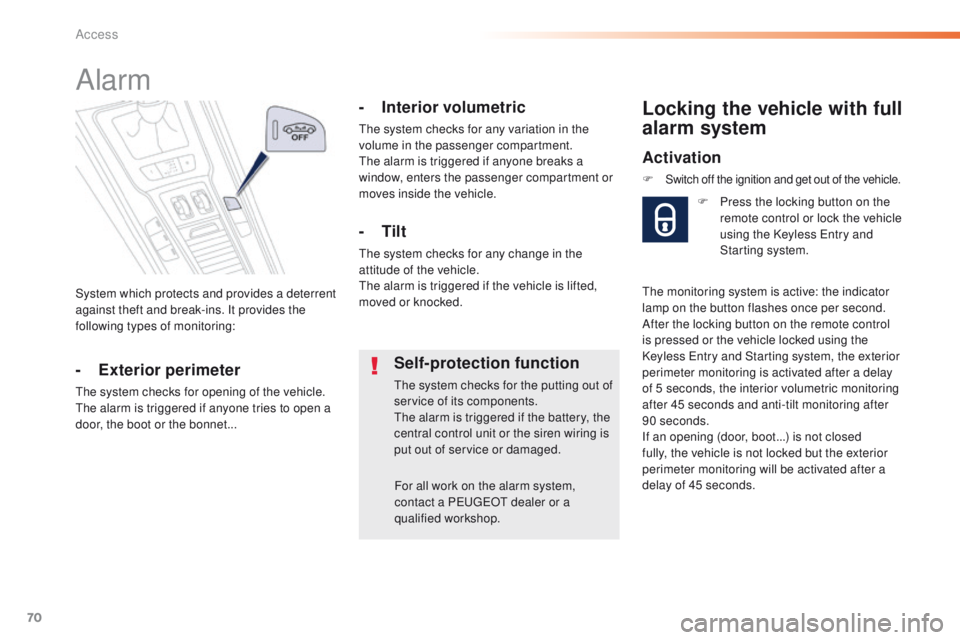
70
508_en_Chap02_ouvertures_ed01-2016
System which protects and provides a deterrent
against theft and break-ins. It provides the
following types of monitoring:
Alarm
- Exterior perimeter
the system checks for opening of the vehicle.the alarm is triggered if anyone tries to open a
door, the boot or the bonnet...
- Interior volumetric
the system checks for any variation in the
volume in the passenger compartment.
th
e alarm is triggered if anyone breaks a
window, enters the passenger compartment or
moves inside the vehicle.
- Tilt
the system checks for any change in the
attitude of the vehicle.
th
e alarm is triggered if the vehicle is lifted,
moved or knocked.
Self-protection function
the system checks for the putting out of
service of its components.
th
e alarm is triggered if the battery, the
central control unit or the siren wiring is
put out of service or damaged.
For all work on the alarm system,
contact a P
e
uge
Ot
dealer or a
qualified workshop.
Locking the vehicle with full
alarm system
Activation
F Switch off the ignition and get out of the vehicle.
F Press the locking button on the remote control or lock the vehicle
using the Keyless
e
n
try and
Starting system.
th
e monitoring system is active: the indicator
lamp on the button flashes once per second.
After the locking button on the remote control
is pressed or the vehicle locked using the
Keyless
e
n
try and Starting system, the exterior
perimeter monitoring is activated after a delay
of 5 seconds, the interior volumetric monitoring
after 45 seconds and anti-tilt monitoring after
90 seconds.
If an opening (door, boot...) is not closed
fully, the vehicle is not locked but the exterior
perimeter monitoring will be activated after a
delay of 45 seconds.
Access
Page 73 of 371
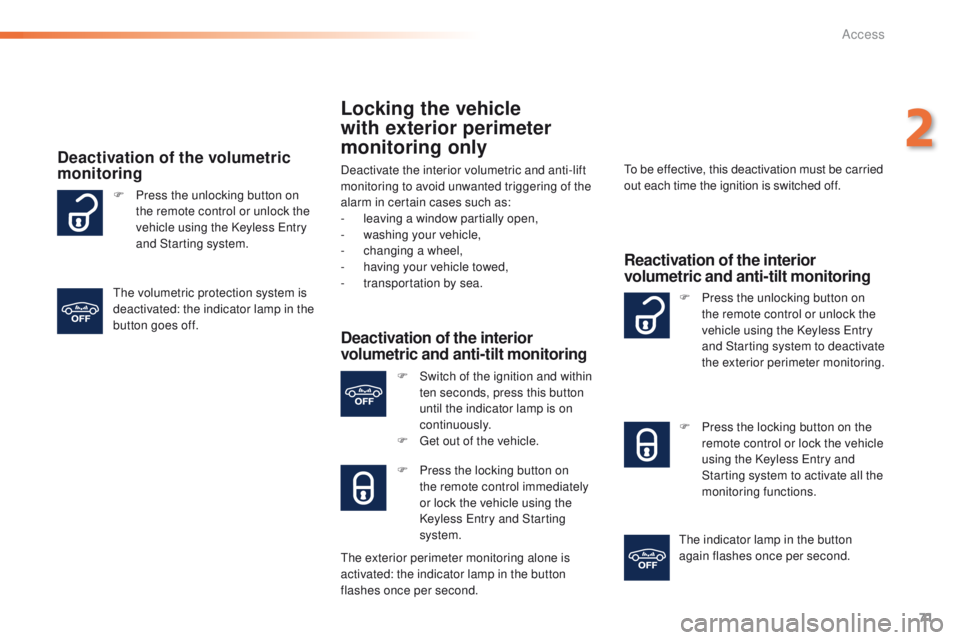
71
508_en_Chap02_ouvertures_ed01-2016
Locking the vehicle
with exterior perimeter
monitoring only
Deactivate the interior volumetric and anti-lift
monitoring to avoid unwanted triggering of the
alarm in certain cases such as:
-
l
eaving a window partially open,
-
w
ashing your vehicle,
-
c
hanging a wheel,
-
h
aving your vehicle towed,
-
t
ransportation by sea.
Deactivation of the interior
volumetric and anti-tilt monitoring
F Switch of the ignition and within ten seconds, press this button
until the indicator lamp is on
continuously.
F
g
e
t out of the vehicle.
F
P
ress the locking button on
the remote control immediately
or lock the vehicle using the
Keyless
e
n
try and Starting
system.
to b
e effective, this deactivation must be carried
out each time the ignition is switched off.
Reactivation of the interior
volumetric and anti-tilt monitoring
F Press the unlocking button on the remote control or unlock the
vehicle using the Keyless
e
n
try
and Starting system to deactivate
the exterior perimeter monitoring.
F
P
ress the locking button on the
remote control or lock the vehicle
using the Keyless
e
n
try and
Starting system to activate all the
monitoring functions.
th
e indicator lamp in the button
again flashes once per second.
F
P
ress the unlocking button on
the remote control or unlock the
vehicle using the Keyless
e
n
try
and Starting system.
Deactivation of the volumetric
monitoring
the volumetric protection system is
deactivated: the indicator lamp in the
button goes off.
th
e exterior perimeter monitoring alone is
activated: the indicator lamp in the button
flashes once per second.
2
Access
Page 75 of 371
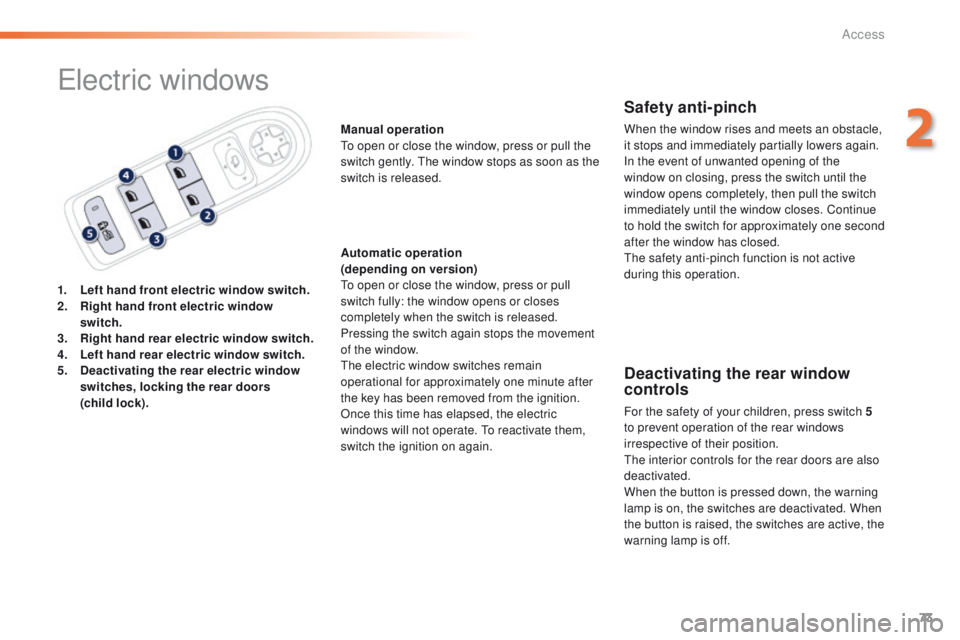
73
508_en_Chap02_ouvertures_ed01-2016
electric windows
1. Left hand front electric window switch.
2. Right hand front electric window
switch.
3.
R
ight hand rear electric window switch.
4.
Le
ft hand rear electric window switch.
5.
D
eactivating the rear electric window
switches, locking the rear doors
(child
lock). Manual operation
to o
pen or close the window, press or pull the
switch gently. t
h
e window stops as soon as the
switch is released.
Automatic operation
(depending on version)to o pen or close the window, press or pull
switch fully: the window opens or closes
completely when the switch is released.
Pressing the switch again stops the movement
of the window.
the
electric window switches remain
operational for approximately one minute after
the key has been removed from the ignition.
Once this time has elapsed, the electric
windows will not operate.
t
o r
eactivate them,
switch the ignition on again.
Safety anti-pinch
When the window rises and meets an obstacle,
it stops and immediately partially lowers again.
In the event of unwanted opening of the
window on closing, press the switch until the
window opens completely, then pull the switch
immediately until the window closes. Continue
to hold the switch for approximately one second
after the window has closed.
th
e safety anti-pinch function is not active
during this operation.
Deactivating the rear window
controls
For the safety of your children, press switch 5
t o prevent operation of the rear windows
irrespective of their position.
th
e interior controls for the rear doors are also
deactivated.
When the button is pressed down, the warning
lamp is on, the switches are deactivated. When
the button is raised, the switches are active, the
warning lamp is off.
2
Access
Page 76 of 371
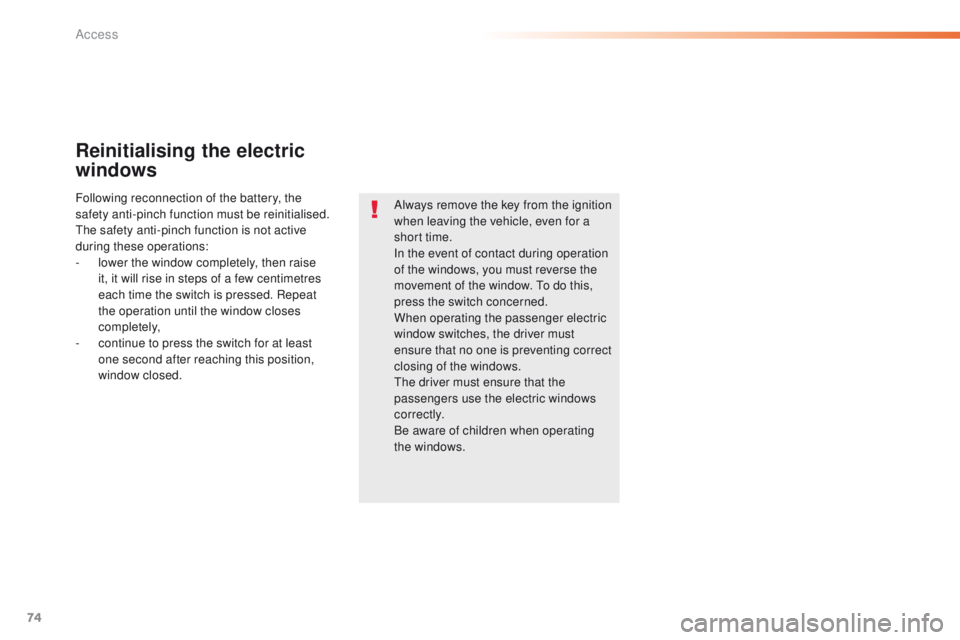
74
508_en_Chap02_ouvertures_ed01-2016
Reinitialising the electric
windows
Always remove the key from the ignition
when leaving the vehicle, even for a
short time.
In the event of contact during operation
of the windows, you must reverse the
movement of the window. t
o d
o this,
press the switch concerned.
When operating the passenger electric
window switches, the driver must
ensure that no one is preventing correct
closing of the windows.
th
e driver must ensure that the
passengers use the electric windows
c o r r e c t l y.
Be aware of children when operating
the windows.
Following reconnection of the battery, the
safety anti-pinch function must be reinitialised.
th
e safety anti-pinch function is not active
during these operations:
-
l
ower the window completely, then raise
it, it will rise in steps of a few centimetres
each time the switch is pressed. Repeat
the operation until the window closes
completely,
-
c
ontinue to press the switch for at least
one
second after reaching this position,
window closed.
Access
Page 85 of 371

83
508_en_Chap03_ergonomie-et-confort_ed01-2016
Heating and Ventilation
Air intake
the air circulating in the passenger compartment
is filtered and originates either from the outside via
the grille located at the base of the windscreen or
from the inside in air recirculation mode.
Controls
the incoming air follows various routes
depending on the controls selected by
the driver, the front passenger and rear
passengers, according to the level of
equipment.
th
e temperature control enables you to obtain
the level of comfort required by mixing the air of
the various circuits.
th
e air distribution control enables you to
select the air vents used in the passenger
compartment by the combined use of the
associated buttons.
th
e air flow control enables you to increase or
reduce the speed of the ventilation fan.
th
ese controls are grouped together on control
panel A on the centre console. 1.
W
indscreen demisting/defrosting vents.
2.
F
ront side window demisting/defrosting
vents.
3.
S
ide adjustable air vents.
4.
C
entral adjustable air vents.5.
A
ir outlets to the front footwells.
6.
A
djustable air vents for the rear
passengers.
7.
A
ir outlets to the rear footwells.
Air distribution
3
ease of use and comfort
Page 87 of 371
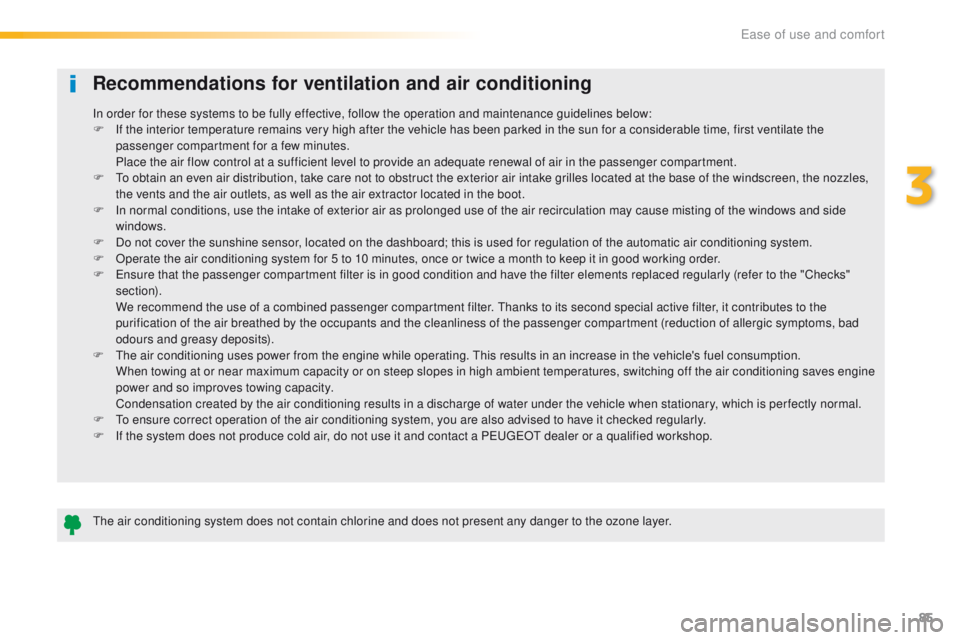
85
508_en_Chap03_ergonomie-et-confort_ed01-2016
Recommendations for ventilation and air conditioning
the air conditioning system does not contain chlorine and does not present any danger to the ozone layer. In order for these systems to be fully effective, follow the operation and maintenance guidelines below:
F
I
f the interior temperature remains very high after the vehicle has been parked in the sun for a considerable time, first ventilate the
passenger compartment for a few minutes.
P
lace the air flow control at a sufficient level to provide an adequate renewal of air in the passenger compartment.
F t
o o
btain an even air distribution, take care not to obstruct the exterior air intake grilles located at the base of the windscreen, the nozzles,
the vents and the air outlets, as well as the air extractor located in the boot.
F
I
n normal conditions, use the intake of exterior air as prolonged use of the air recirculation may cause misting of the windows and side
windows.
F
D
o not cover the sunshine sensor, located on the dashboard; this is used for regulation of the automatic air conditioning system.
F
O
perate the air conditioning system for 5 to 10 minutes, once or twice a month to keep it in good working order.
F e
n
sure that the passenger compartment filter is in good condition and have the filter elements replaced regularly (refer to the "Checks"
section).
W
e recommend the use of a combined passenger compartment filter. t
h
anks to its second special active filter, it contributes to the
purification of the air breathed by the occupants and the cleanliness of the passenger compartment (reduction of allergic symptoms, bad
odours and greasy deposits).
F t
h
e air conditioning uses power from the engine while operating. t
h
is results in an increase in the vehicle's fuel consumption.
W
hen towing at or near maximum capacity or on steep slopes in high ambient temperatures, switching off the air conditioning saves engine
power and so improves towing capacity.
C
ondensation created by the air conditioning results in a discharge of water under the vehicle when stationary, which is per fectly normal.
F t
o e
nsure correct operation of the air conditioning system, you are also advised to have it checked regularly.
F
I
f the system does not produce cold air, do not use it and contact a P
e
uge
Ot
dealer or a qualified workshop.
3
ease of use and comfort